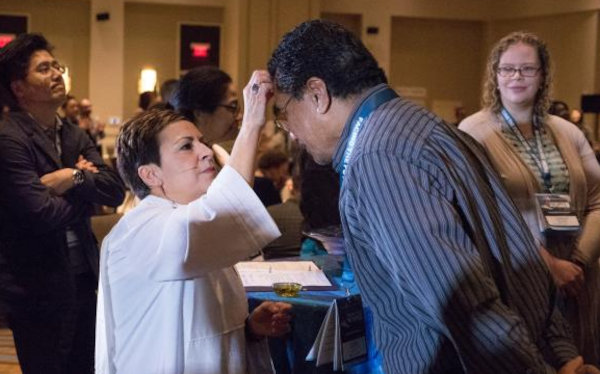“Facing the Future” equips both clergy and congregants to overcome cultural obstacles to ministry.
JOEY BUTLER
United Methodist News Service
While the number of people of color entering ministry grows, the main demographic of The United Methodist Church remains 94 percent white in the U.S. This means there are more and more pastors serving congregations that don’t look like them.
To help equip those pastors in their ministry, the United Methodist Commission on Religion and Race organized Facing the Future conferences. Three hundred pastors in cross-racial/cross-cultural appointments traveled to Newark, New Jersey, May 7-9 for the third installment of Facing the Future.
Erin Hawkins, top executive of the Commission on Religion and Race, referenced the ever-present racial tensions that still confront society.
“Pastors serving in cross-racial and cross-cultural appointments can serve as key agents in the task of building beloved community, especially in the face of cultural division,” she said. “If you’re in such an appointment, every time you stand in a pulpit you extend a hand to someone different from you and say, ‘Let’s make this journey together.’”
Looking out amongst the mostly non-white crowd, Hawkins asked, “When was the last time you were in a setting with this much diversity? If we’re going to be a vital church in 50 years, more of our local churches will have to look like this event.”
Even the worship service music reflected the enormous diversity of the attendees, ranging from reggae to Latin, African and Asian folk, and even a rollicking blues.
Facing the Future offered several opportunities for the clergy to share their stories and concerns with others in their situation. Peer-to-peer conversations were cited as an area of significant need for pastors who frequently have no one around them who may understand their reality, which can be isolating.
The Rev. Clarence Brown, senior pastor at Annandale United Methodist in Annandale, Virginia, told attendees, “Every psychiatrist needs a psychiatrist, and every pastor needs a pastor.”
Around conference tables, frustrations were shared. A Korean pastor was criticized by a member of the congregation for “mispronouncing” words with his accent. A black female pastor dealt with white churchgoers touching her long, dreadlocked hair without invitation. An African-American pastor was met with hostility by his wealthy, suburban church after speaking out against the wave of police shootings involving black men because “that doesn’t happen here, so it’s not our problem.”
The Rev. Teresita Matos-Post of the Greater New Jersey Conference reflected to the conference her difficult experience in a cross-racial appointment that ended after only 20 months.
“I was a confidently outspoken Puerto Rican pastoring a white church. I challenged what I thought to be the sins of the church, and the very sound of my voice was interpreted as an abuse of power,” she said, adding that she became known as “the angry pastor.”
But Matos-Post acknowledged that the cultural divide works both ways.
“I underestimated the power of my own biases. I didn’t love that church as they were, unconditionally,” she said. “As a Latina, being called angry isn’t new or original. Micro aggressions require us to respond with macro grace.”
Throughout the conference, the need for greater training and understanding for both pastor and congregation was cited.
In a workshop on intercultural competency, the Rev. Giovanni Arroyo, Religion and Race’s team leader for program ministries, shared his experience being appointed to a culturally German congregation and realizing his entire ministry was in a Latino context — even down to the fact that he read the Lord’s Prayer from the New Revised Standard Version of the Bible when his church preferred the King James.
Other workshops dealt with recognizing implicit bias, clergy wellbeing, spiritual formation with various spiritual types, and worship as an agent for change.
Ohio West Area Bishop Gregory Palmer gave the first night’s sermon and noted that he’s been in a cross-racial appointment since at least 1990 — holding positions as a district superintendent, annual conference staff and, eventually, bishop.
“My first episcopal assignment was in Iowa, where only 2.9 percent of people looked like me,” Palmer said.
Despite their inherent challenges, Palmer insisted that cross-racial/cross-cultural appointments should be seen as doing the work of the gospel.
“The church is in the business of bringing people together and crossing boundaries,” he said. “Others are in the business of building walls; we’re in the business of tearing them down.”
The Commission on Religion and Race is developing resources for both churches and clergy involved in cross-racial/cross-cultural appointments. Learning from Strangers: Best Practices for Cross-Racial and Cross-Cultural Ministry is meant for local churches and cabinets. A workbook on implicit bias will be available in June.
To ensure the conversation continues beyond the conference, online conversation groups were organized and are scheduled to convene May 15-17. The 37 topics suggested by attendees include designing new worship in other languages, measuring “success” in a cross-racial appointment, recovering from an appointment the pastor doesn’t consider a success, training churches to receive a cross-racial appointment and several issues related to self-care and support.
Hawkins encouraged all in attendance to “engage in these conversations and be a part of developing what’s next.”
In her closing sermon, Louisiana Area Bishop Cynthia Fierro Harvey said, “This room is what I think heaven must look like — and I didn’t have to die to see it.”
Last Updated on October 27, 2023

